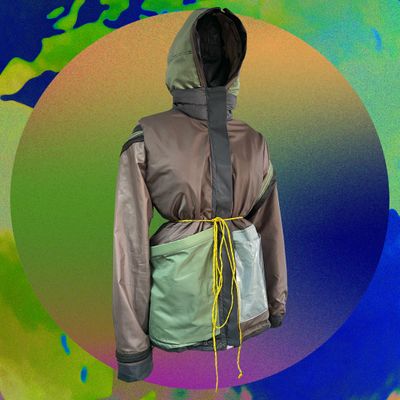
In recent years, sustainability has become an increasingly ubiquitous buzzword in the fashion industry. Customers say they want to be ethical consumers, buying vintage and upcycling on Depop. Reformation calls itself the most sustainable option other than being naked, while Eileen Fisher has pledged to use “sustainable materials” in 100 percent of its products. Yet what sustainability actually means in this context has become increasingly nebulous. H&M launched a 2019 Conscious collection that was anything but ecoconscious; ASOS advertised nonrecyclable pants as 100 percent recyclable; and Uniqlo appointed a cartoon cat as its global sustainability ambassador while depriving Vietnamese garment workers millions in severance pay. Ecoconscious marketing only goes so far in an industry responsible for 10 percent of global carbon emissions, rapid deforestation, and 60 million tons of plastic waste per year — including microplastics that get released into the ocean and atmosphere whenever we wear or wash polyester. Not to mention the industry’s human cost: Per the Clean Clothes Campaign, only about 2 percent of the world’s 60 million garment workers earn a living wage.
This tension is front of mind for the next generation of fashion students. Nina Alhadeff, a Barnard College senior who serves as an adviser to the Columbia Undergraduate Fashion Society, says that a lot of her peers are interested in pursuing “sustainability related” paths: “Not a lot of people are saying, I want to go work for Dior because I love Dior. It’s: I want to be part of their ESG” — referring to the governance boards that uphold a corporation’s ethical criteria, including pollution prevention and labor rights.
Most traditional fashion programs now offer sustainability courses but approach the subject inside silos — students take biology and broad offerings on “ecology and environmental problems” — while issues of neocolonialism and human rights go unexplored. The Slow Factory (named as a counterargument to, say, fast fashion) is a Brooklyn-based school that believes students can’t reduce harm without learning the full context of the damage the industry has caused: “We address the impacts of colonialism, imperialism, and white supremacy on the planet, and how those systems were designed to extract and exploit resources and labor,” says activist and designer Celine Semaan, who founded the virtual, non-degree school as a way of offering free sustainable fashion education to anyone, regardless of academic qualifications. The school currently enrolls 28,000 students, from Gen-Z fashion students to boomer scientists, and its syllabus offers everything from more traditional topics like ecological literacy to unlearning Euro-centric beauty standards and racism in fast fashion. “An open education is what they won’t teach you in school,” says Semaan. “In real life, you can’t omit human life when you’re talking about climate justice. It’s not how our ecosystem works.” During sustainability literacy classes, students shift their thinking away from linear, Western systems — where a garment is made in a sweatshop, worn in the West, and later donated, only to get hauled off to a Global South landfill — to regenerative loops, where waste is recycled back into the earth. Slow Factory students get intimate with recycling waste by touring landfills and are encouraged to consider the end of a product’s life before the beginning.
Many students say they gravitated to the Slow Factory because they were skeptical or alienated by existing sustainability initiatives in the industry, which often felt like greenwashing — organizations marketing themselves as more ecofriendly than they are — and cultural erasure. “White supremacy and capitalism paint this image of white people being at the front of sustainability, when they’re just beginning to practice what has already been passed down for generations,” says designer Sayo Watanbe. There’s also the issue of accessibility. Because ecofriendly materials are generally more expensive to manufacture, clothes marketed as sustainable are often luxuries for a privileged few — for instance, a camisole at Reformation costs $128, while a sweater by sustainable designer Gabriela Hearst is nearly $2,000. “As a Black woman and single parent on government benefits, I’m not the target market for brands creating truly sustainable fashion. I wanted to find my tribe,” says Natasha Mays, a former London College of Fashion student who now takes classes at Slow Factory. For the school’s Waste-Led Design challenge, Mays made trench coats out of festival tents bound for U.K. landfills, turning them into jacket shells that she stuffed with shredded old baby clothes. Charlotte Bohning and Mary Lempres, industrial design students at Pratt, created biodegradable charcoal nipple pasties (the Wastie Pastie) out of food waste that you can compost after wearing. And Watanbe re-covered food delivery mailers to make handbags.
Still, good intentions only go so far. Recycled material isn’t necessarily biodegradable or compostable, and some experts suggest fashion companies need to go further than just using recycled materials to truly lower textile-mill emissions, which account for 76 percent of a garment’s carbon footprint. It’s also difficult to scale slow fashion if you don’t have the brand hype of ecogiants like Reformation (which still doesn’t pay 100 percent of its workers a living wage) or Everlane. To actually get sustainable products down to competitive price points takes time, and there’s always a rub: You can study ecojustice, but you’re still working in a field where human rights violations are ubiquitous as Shein crop tops.
Instead of getting lost in buzzwords or vague idealism, model Amber Valletta — who has been involved in sustainability activism since 2014 and was recently named the Fashion Institute of Technology’s sustainability ambassador — advises students to hone in on specific issues, like water conservation and bio-based fibers. Still, it may be a losing battle. Recent reports from the Intergovernmental Panel on Climate Change spell imminent climate doom — and we’re running out of time to change course. “We can’t buy or innovate our way out of the climate crisis,” says Aditi Desai, who is pursuing a master’s degree at Columbia’s sustainability management program.
Barnard professor Anne Higonnet, who teaches a seminar on clothing, wonders if what might be most impactful for students is a value shift away from today’s culture of waste, where we buy more clothes than ever but never keep them for long. For their final assignment, Higonnet’s students write essays about clothing memories, whether that’s putting on a deceased parent’s sweater or a dress that makes them feel self-assured. “They think about how many precious memories they have associated with clothing,” Higonnet says. That makes them more likely to think of a wardrobe as something that’s meant to last a long time — and as something that should be designed to.





